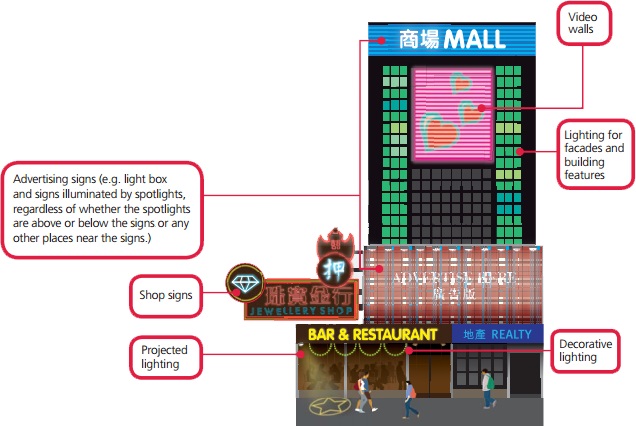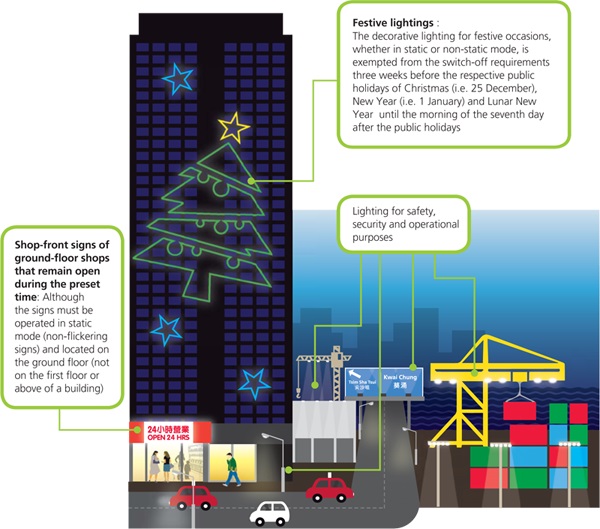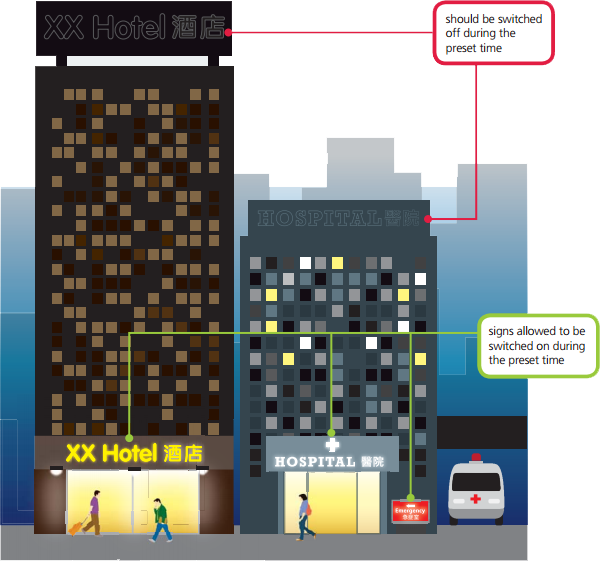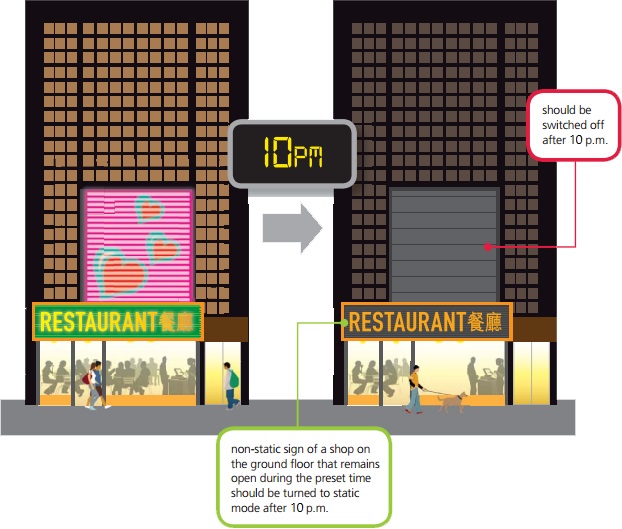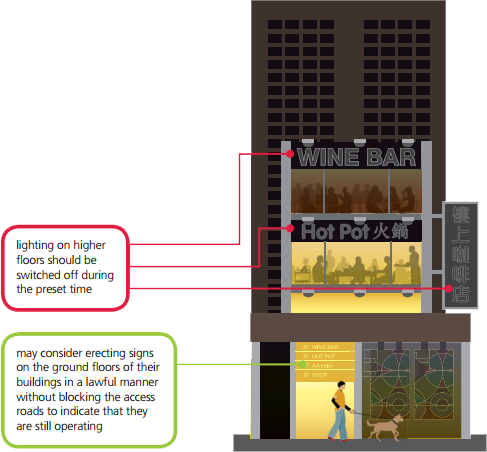FAQ
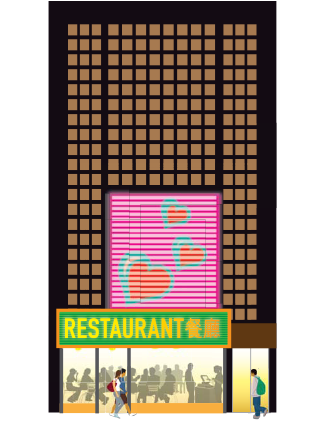
Purpose of the Charter on External Lighting
Due to the high density of buildings in Hong Kong, external lighting at night may cause nuisance to residents in the vicinity. Switching off unnecessary external lighting during the preset time can foster a better nighttime environment, which is conducive for the public to rest.
| (i) | Property management companies |
| (ii) | Owners of advertising signs or advertising agencies responsible for the management of advertising signs |
| (iii) | Hotels, shopping malls, shops, restaurants and public bodies and organisations, etc. with external lighting installations or signboards |
| (i) | publish the names of participating organisations and shops on government websites |
| (ii) | award certificates of participation to participating organisations and shops |
| (iii) | distribute stickers of the Charter on External Lighting to participating organisations and shops for display at their websites and shops |
Responsibilities of Participants of the Charter on External Lighting
Responsibilities of Participants of the Charter on External Lighting
In 2025/26, the exemption period will be from 10 p.m. on 4 December 2025 to 7 a.m. on 8 January 2026, and from 10 p.m. on 27 January 2026 to 7 a.m. on 26 February 2026.
Generally speaking, a shop-front sign is a sign erected at such location as the entrance to a shop on the ground floor for displaying the shop name and logo. It may be a light box, signs illuminated by spotlights, etc.
Signs on top of the buildings that are covered by the Charter on External Lighting should be switched off during the preset time. Signs erected on higher floors of buildings would likely cause light nuisance to residents nearby. Also, as Hong Kong has high building density and establishments like hotels and hospitals are mostly located in prominent areas with signs on the ground floor, guests and patients should not have problems locating these buildings. Therefore, signs on top of buildings should be switched off at the preset time.
No. Since the light nuisance caused by non-static signs is generally more significant and irritating than that of static signs, any non-static lighting installations for decorative, promotional or advertising purposes (e.g. non-static signs, video walls, etc.) should be switched off after 10 p.m. If the non-static sign is a shop-front sign of a shop on the ground floor that remains open during the preset time, it should be turned to static mode after 10 p.m.
Taking into account the community’s tradition of viewing Christmas lights as well as the operational needs of the tourism and hotel sectors, etc., and the district celebration activities, the Charter on External Lighting allows flexibility for festive lighting during the public holidays of Christmas, New Year and Lunar New Year by exempting such lighting from the switch-off requirements at the preset time. Other external lighting installations (e.g. signs), however, have no direct relation to festive lighting. Participants should switch off the external lighting installations for promotional or advertising purposes during the preset time to reduce light nuisance caused by external lighting installations.
No. Signs erected on higher floors of a building stand a higher chance of causing light nuisance to the residents nearby. Even if the shops concerned remain open, lighting should be switched off during the preset time. Upper-floor shops that remain open after the preset time may consider erecting signs on the ground floors of their buildings in a lawful manner without blocking the access roads to indicate that they are still operating.
Upper-floor shops include those shops located on the first floor or above of a building. As signs erected on the higher floors of a building stand a higher chance of causing light nuisance to the residents nearby, even if the shops concerned (regardless of whether these shops are located on the ground floor, or the first floor or above of a building) remain open, their upper-floor signs (i.e. signs installed on the first floor or above of a building) should be switched off during the preset time.
The Charter on External Lighting applies to all districts in Hong Kong. All lighting of decorative, promotional or advertising purposes that affect the outdoor environment, regardless of whether erected on commercial buildings or residential buildings, should be switched off during the preset time.
Lighting installations of a sign (regardless of whether the spotlights are erected on the top or bottom of the sign, or any associated positions near the sign) fall within the scope of the Charter on External Lighting and should be switched off during the preset time even if they do not form part of the sign.
We encourage owners of shops with multiple external lighting installations to switch off the lighting of decorative, promotional or advertising purposes that affect the outdoor environment during the preset time. The shops can still participate in the Charter on External Lighting so long as the owners only switch on those lighting installations for safety or operational needs during the preset time.
The Charter on External Lighting encourages all enterprises and organisations to switch off their lighting of decorative, promotional or advertising purposes during the preset time. We welcome individual shops of each chain store group or individual restaurants of each catering group to pledge to switch off external lighting from 10 p.m., 11 p.m. or midnight to 7 a.m. on the following day according to their operational needs.
Due to the high building density and close proximity of commercial and residential premises, the multiple and cumulative light sources might cause light nuisance to the residents even if the lighting installations have been dimmed down. Moreover, it would be difficult to assess whether the luminance level of each lighting installation is appropriate or would be accepted by the residents in the vicinity. Therefore, it is more practicable to require participants of the Charter on External Lighting to switch off the external lighting during the preset time.
Yes. The Charter on External Lighting allows shops that remain open during the preset time to switch on the shop-front signs in static mode. However, if the sign is located on the first floor or above of the building, it should be switched off even if the shop on the ground floor is still in operation after the preset time to avoid causing any nuisance to the residents nearby. Also, we encourage the participants of the Charter on External Lighting operating overnight to consider adopting positive measures by switching off part of the lighting installations (e.g. fluorescent lights and light bulbs) so that lights can focus on the name or logo of the shop in order to minimise nuisance to residents nearby.
As regards external lighting installations erected for multiple purposes, exemptions will be granted to such lighting so long as the participants of the Charter on External Lighting pledge to switch off unnecessary external lighting during the preset time and confirm that the external lighting installations which remain in operation have to be switched on for safety and security purposes or due to operational needs. However, if the Government receives any complaints about the nuisance caused by these installations and the complaints are found to be justified following site inspection by the Government, the participating organisations concerned will be asked to switch off the lighting under complaint during the preset time. If they refuse to switch off the relevant lighting during the preset time, they will be removed from the list of participants of the Charter on External Lighting.
Monitoring the effectiveness
Monitoring the effectiveness
Although the Charter on External Lighting is a voluntary scheme, we believe the participants will fulfill their pledge seriously. We have also set up a website for announcing the list of participants of the Charter on External Lighting, and published their names on relevant government websites to raise public awareness of the Charter on External Lighting. If the Government receives any complaints about the nuisance caused by the external lighting installations of the participants of the Charter on External Lighting, and the complaints are found to be justified following site inspection by the Government, the responsible persons of the participants of the Charter on External Lighting will be asked to switch off the lighting under complaint during the preset time. If they refuse, the participants concerned will be removed from the list of participants of the Charter on External Lighting.
